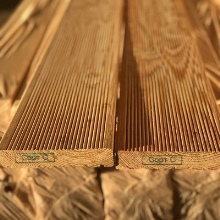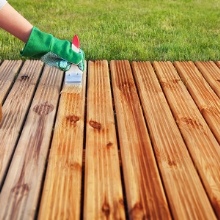Larch decking

When decorating a balcony, veranda, terrace, the choice of material is of strategic importance. The material must be loyal to external influences, that is, its performance characteristics must have a high coefficient of wear resistance. And these criteria include Siberian larch decking.


Peculiarities
This material demonstrates excellent resistance to deformation and natural attack. He, of course, also has disadvantages, but the advantages overlap them. Let's see why larch decking is preferred to other materials:
- it is a product with high elasticity, tensile strength;
- it looks good: its texture and texture make the finish look solid and elegant;
- the resinous structure of the board makes it resistant to biological effects;
- the thermal conductivity of the board is low, the material is warm to the touch and comfortable for everyday use;
- the operation of the material is also economical: the terrace board does not have to be renewed every year due to processing with protective coatings;
- in conditions of high humidity, the service life of the board does not decrease;
- installation of the board can be done independently.



Nevertheless, it is worth noting the minus of decking: it reacts relatively negatively to the sun. If the board is laid in the form in which it was purchased, the merciless ultraviolet light will indeed affect the appearance of the material over time. But if you immediately cover the board with varnish or special impregnation, this minus disappears. Another point that worries the buyer is the price. Indeed, decking will cost more than many other finishes, but it matches its price. You will definitely have to take care of the decking: this way the coating will last much longer and retain its attractive appearance. If it is noticed that the board has become dull, it must be treated with a protective oil.
The coating is cleaned twice a year, and then covered with oil, always in several layers. So it will be possible not only to get rid of the dull gray shade, but also to focus on the natural color of the board. You can also use a special cleaner: it is used if the gray coating has already become expressive. The composition of the cleaner is able to open wood pores and renew the top layer. This product is usually sold in powder form. It is poured onto a cleaned and already moistened board, and then washed off after 20-25 minutes.
Also, to give a chance to the lost color, you can use a saturator. It is usually used in conjunction with a cleaner.



Views
Larch boards differ in the relief of the outer surface. It is difficult to say which relief will be better. The choice must be made based on personal preference.
"Velveteen"
These products are distinguished by a corrugated surface with a special texture. In this form, the anti-slip properties of the board will be more expressive, even if a lot of water and dirt accumulates on the surface (front side). This larch board is often laid by the pool.



Smooth
A special coating is applied to this type of board - "anti-slip". It looks very impressive, although the board can become slippery in excessive humidity. From time to time, the anti-slip coating needs to be renewed. Often these types of boards are called one-sided and two-sided. This is not a completely correct characteristic. One-sided means "corduroy" board, in which one side is grooved, and the other is not.But smooth on both sides is almost the same, hence the name. You can choose the color of the boards, there are options.


Classes and varieties
The manufacturer offering the material divides it into different varieties, which depend on the technical characteristics, namely: the number of knots and sapwood. The "Extra" decking is considered to be of high quality. This will be the most expensive material, on the front side of which there can be no knots and other, even the smallest defects.
There are several other classes as well.
- Prima. Flaws are allowed on the board, but minor. Usually a board of this class has a homogeneous structure, occasionally one knot is noticeable on individual elements.
- Variety A. There are almost no defects, the panels can be used without additional processing.
- Grade B. The surface of the board is smooth, a couple of knots are allowed on it.
- AB. The decking has no defects, but in the same batch the boards may slightly differ in color.
- C. This variety does not differ in quality, there are many knots.
In terms of consumer preferences, the AB variety can be considered the most sought after due to its value for money.



Dimensions (edit)
The geometry of a standardized board is always the same: the width of the decking is from 90 to 140 millimeters, the length is 3-6 meters. The thickness fluctuates in a wide range: the optimal (and most in demand) parameters are 28, 35 and 45 millimeters. The thicker the decking, the more expensive it will be. In general, the buyer is guided by weight, length, and parameters, which are most flexible for installation, performed without the involvement of specialists. Of the most requested sizes, the following are worth noting:
- 2000x142x27mm;
- 27x143x4000 mm;
- 27x143x3000 mm;
- 28x140 cm, etc.


Applications
Terrace board is mainly used for laying out the floor on the veranda (in everyday life), it can often be found as a floor covering for concert venues and sports facilities. It is used to decorate rooms with high humidity: for a bath or sauna, decking will be an excellent option.
They also decorate the terrace with it (which is easy to guess from the name), the floors of outdoor openings to the house. In recent years, decking has become especially popular for finishing balconies. He also forms the surface by the pool, piers and piers, gazebos and other open buildings, where rain is not excluded.


How to choose?
Any lumber must be carefully examined when purchasing. It is necessary to check the declared specifications to ensure that the material meets them. For example, it is imperative to see if the declared width is the same throughout the length of the board. The moisture level of wood is also being studied: this indicator should not go beyond 12%, but it should not be less than 8.
Now we will give more detailed advice on choosing a decking board.
- If the choice must meet the criteria for environmental friendliness, a board made of natural wood (solid wood) will be preferable. It should be strong natural wood, moisture-resistant and heat-resistant. Usually this is the wood of exotic crops (sequoia or teak, for example). But larch is also good - among domestic trees it is the # 1 species for decking.
- Often the choice falls on a board made of the so-called thermolarch. This means that the board is heat-treated. Interestingly, this technology has been used since the days of the Vikings. Today wood is "hardened" with a special steam action. And this treatment significantly changes the characteristics of the tree: it becomes inert to moisture, sunlight and other aggressive external factors. And since varnishes and impregnations are not used to improve the properties of decking, heat-treated wood can be considered environmentally friendly.
- WPC decking (wood-polymer composite) is otherwise called deck. It is very popular, since its price is considered affordable, and its performance properties are beyond praise.In the composition of this board there is a filler (mineral or organic), as well as a binder material: it is usually polymeric, but it can also be natural. WPC is dyed during production or after production: if the first dyeing method is used, the color fastness will be better.
- When choosing a color, the main criterion should be compatibility with the nearby floor covering so that there are no abrupt transitions. If a board made of natural wood is chosen, it is easy to repaint it yourself.
- If the board is chosen for the place where people want to wear rough shoes (not house slippers), it must be dense, otherwise, over time, the effect of a "trodden path" will appear on the material.
- A separate point is the manufacturer. Many Russian companies compete with recognized foreign leaders, and the fact that the products are actively exported confirms the attractiveness of the domestic product.
The main thing is that the seller can provide a quality certificate.



What can be processed?
Whatever type of board was purchased, the question of processing always arises. Often there is a dispute about which would be better: varnish or oil. Varnish is good for everyone, except that it is not the most environmentally friendly material, and its abrasion is high. However, it is familiar, convenient, and inexpensive. Oils are not yet so actively used, but this is due to ignorance of their capabilities.
Nevertheless, treating the board with oils has significant advantages:
- they repel moisture;
- reliably protect the material from the accumulation of dirt;
- do not bubble or peel off;
- protect from cracks and drying out;
- beautifully emphasize the texture of the wood;
- do not allow the rays of the sun to aggressively affect the material.


It is also attractive that modern suppliers offer the buyer completely different oils: with the addition of natural wax, with a colorant, with an anti-slip effect, with antibacterial additives.
Let's take a look at how to properly oil the board:
- the surface of the deck must be cleaned of dust;
- for work, you need to take a brush or roller (you can also soak the board with oil using a sponge);
- the composition must be applied exclusively to a dry board;
- special attention is paid to the ends of the decking: they must be covered carefully, without gaps;
- before flooring, the back of the decking is also covered (usually oil is applied along the wood fibers);
- after the end of the work, all working tools must be treated with white spirit, otherwise it will be impossible to bring them to their initial state later.



A functional larch deck board will become functional in about a week. However, do not forget that natural decking can also be painted. Although such manipulations are especially often not carried out with a larch board: the natural texture of the tree is already the best color. But if you really want to, it is recommended to choose oil and alkyd paints. They are cheap and affordable. Acrylic compounds compete with them, the peculiarity of which is that they give optimal adhesion to the wood base. Acrylic paints and negative weather conditions are not afraid. Polyurethane and latex dyes are also widely used.
It is worth paying attention to protective impregnations. This is the minimum protection for a larch board, which will protect it from adverse external influences. There are products that are strictly focused on protecting against mold and mildew, and they usually contain ingredients that will prevent the decking from fading. There are compositions with a special decorative effect: they contain coloring pigments that give the board any interesting shade. There are also compositions that form a reliable protective barrier on the decking, which is not afraid even of an open flame.
Larch is a beautiful and rather unpretentious breed. It lends itself well to processing, perfectly demonstrates itself in use and is an excellent alternative to more expensive exotic breeds for decking.















The comment was sent successfully.